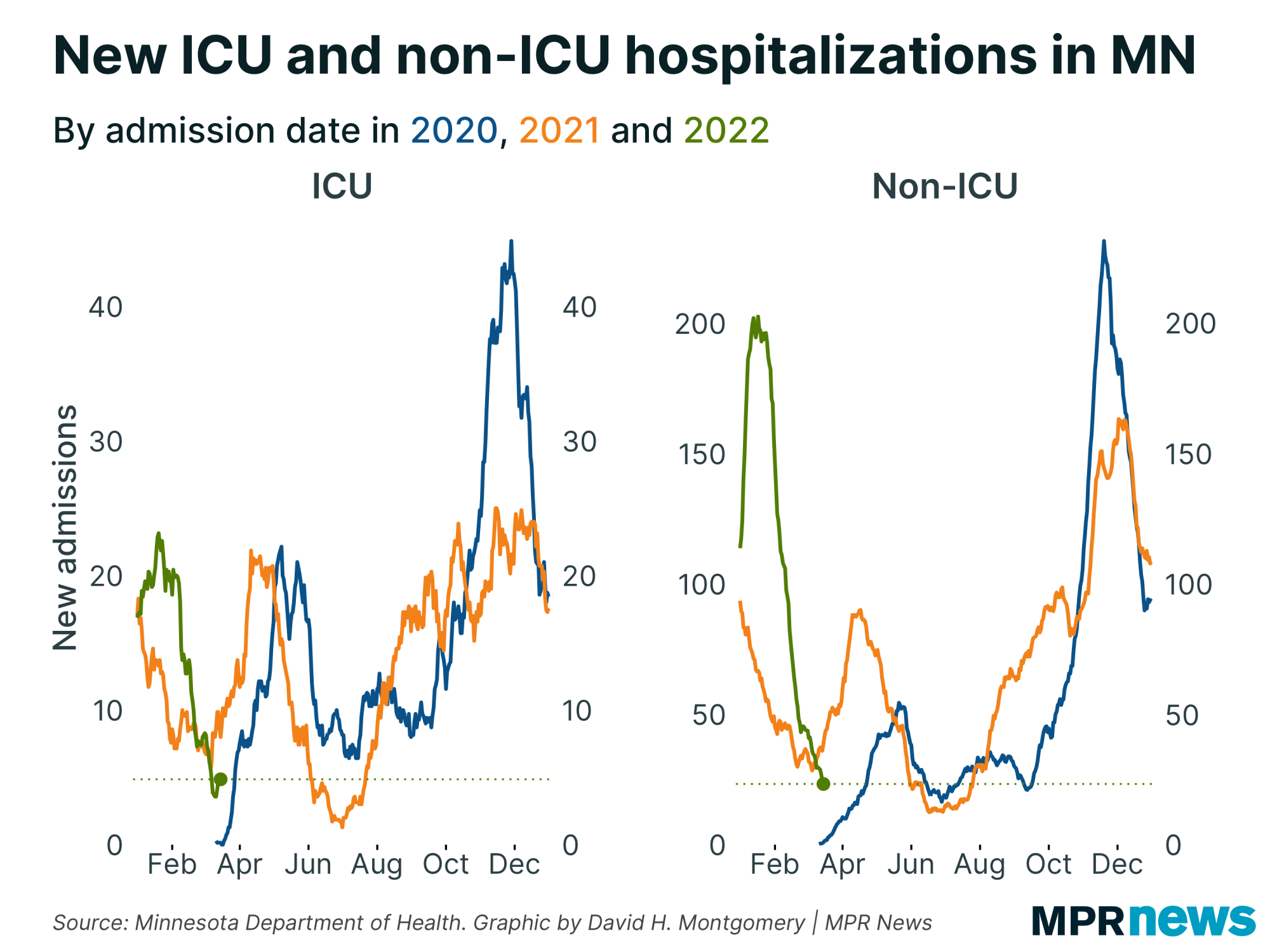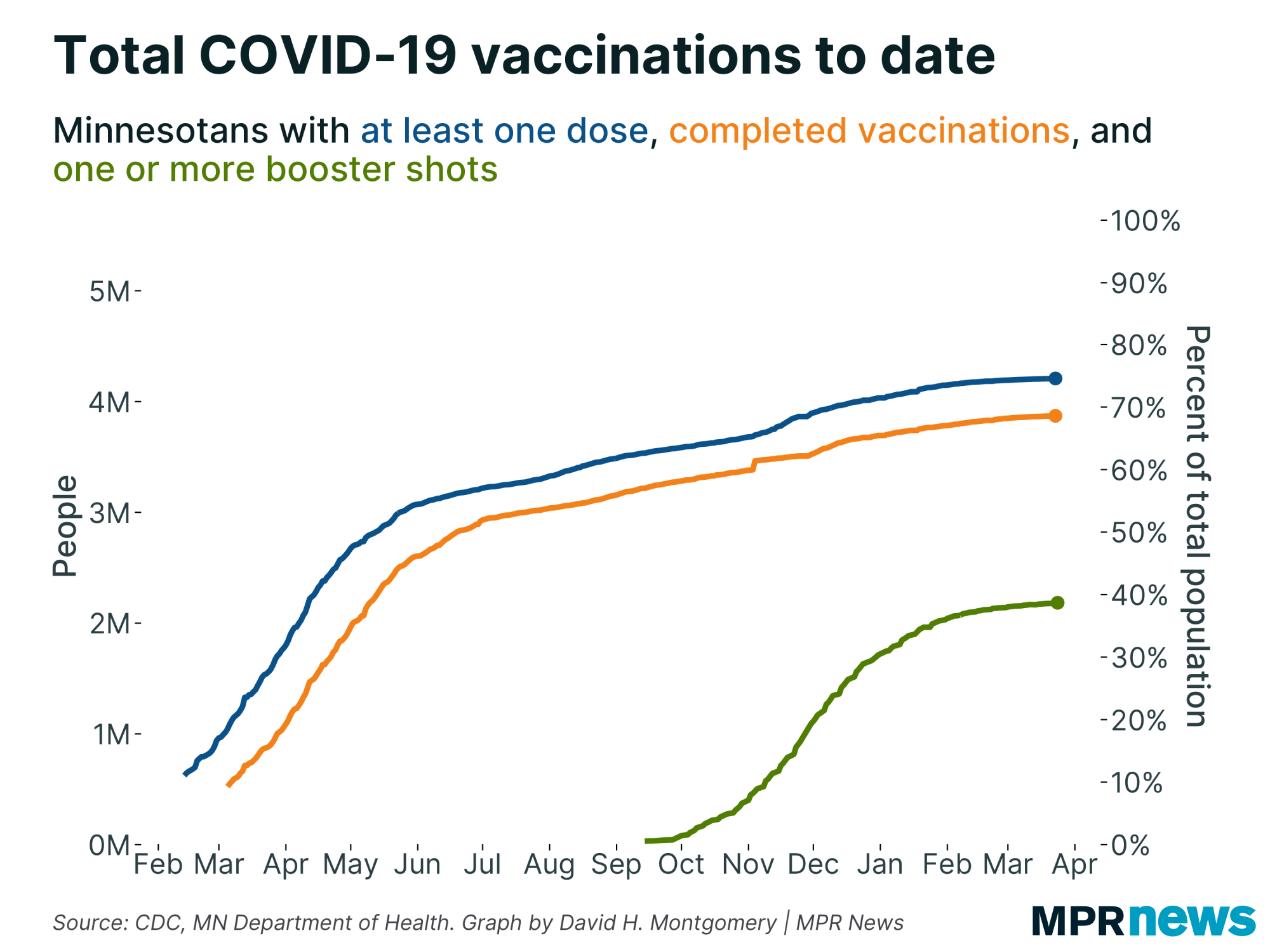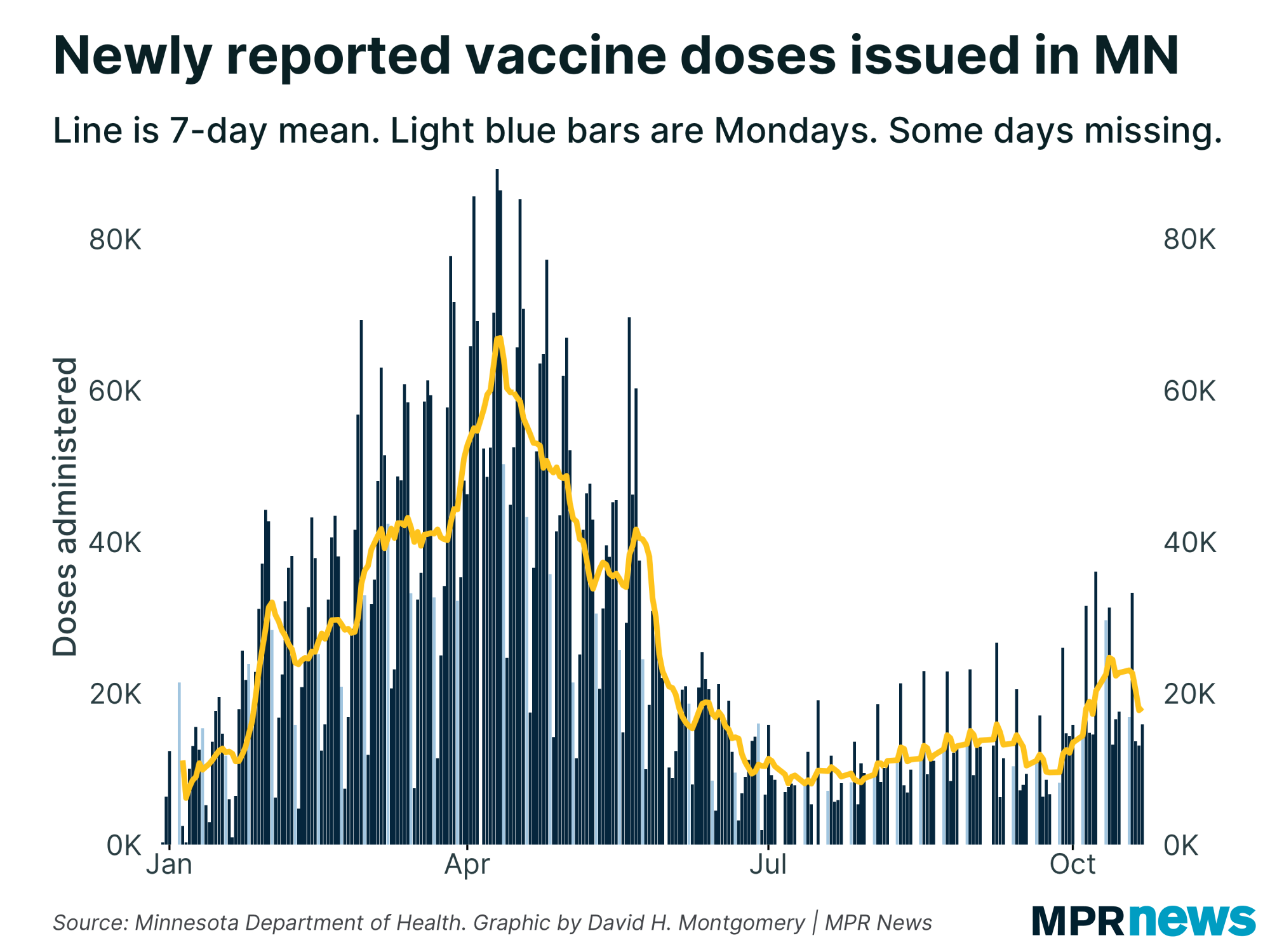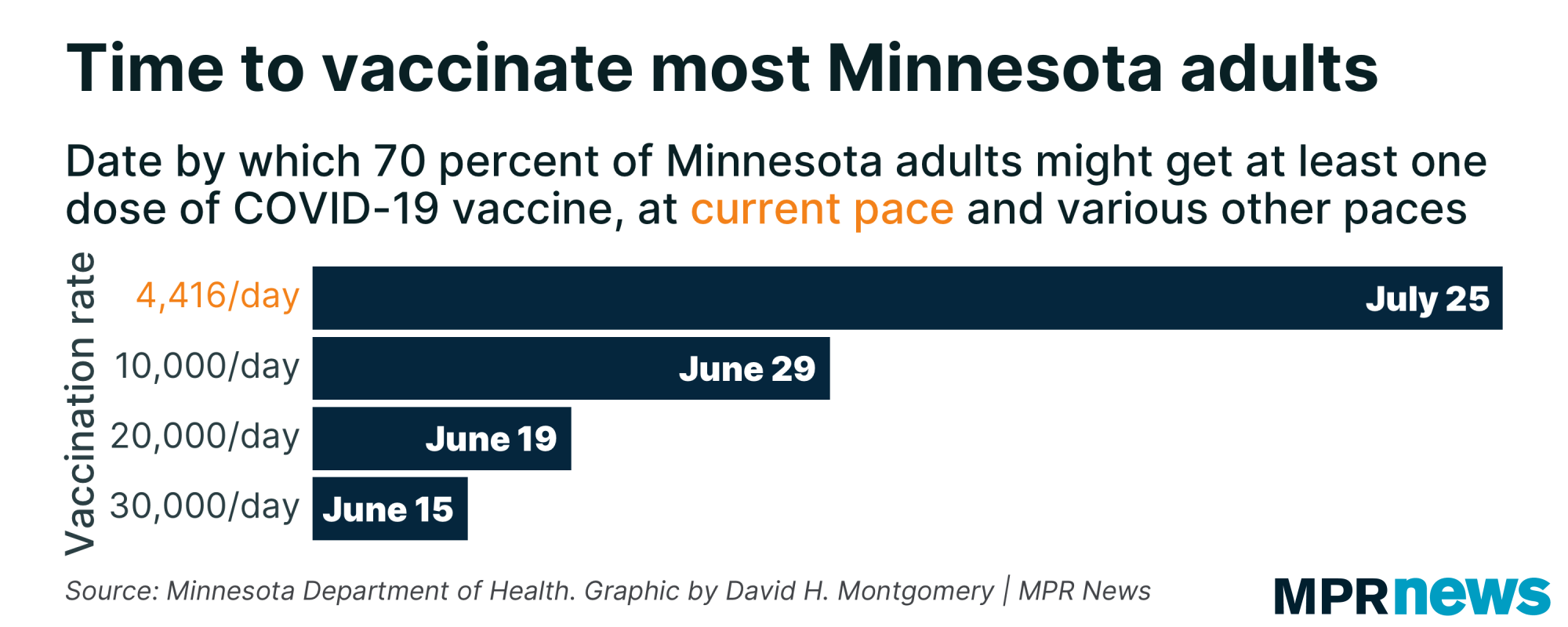May 13 update on COVID-19: More than half of adults fully vaccinated

Go Deeper.
Create an account or log in to save stories.
Like this?
Thanks for liking this story! We have added it to a list of your favorite stories.
3 things to know
60.9 percent of Minnesotans 16 and older have received at least one dose; 50.5 percent — more than 2.2 million people — are now completely vaccinated
Active case counts below 10K for two days; hospitalizations down
Fully vaccinated Minnesotans can go mask-free, indoors and outdoors, starting Friday
Updated 7:15 p.m.
Thursday’s COVID-19 report shows Minnesota’s passed an important milestone in its fight against the pandemic: More than half the state’s 16-and-older residents have all their vaccine shots.
The effort to get the rest vaccinated, however, is turning out to be a challenge. The vaccination pace has collapsed in recent weeks and, despite signs of a possible rebound, it remains at a relative crawl.
About 61 percent of state residents 16 and older have at least one dose of a COVID-19 vaccine now. But with the pace only inching forward, it’ll take longer to reach 70 percent — the threshold Gov. Tim Walz had linked to ending the statewide mask mandate before July 1.
On Thursday, however, Walz announced that he is lifting Minnesota's mask mandate, following new guidance from the Centers for Disease Control and Prevention, saying people who've been fully vaccinated against COVID-19 no longer need to wear face coverings inside in most places. The governor is expected to sign an executive order to end the mask mandate Friday.
Turn Up Your Support
MPR News helps you turn down the noise and build shared understanding. Turn up your support for this public resource and keep trusted journalism accessible to all.

Active cases, hospitalizations down
Despite the slowing vaccination pace, the metrics around the disease continue to show Minnesota’s spring case surge easing.
The count of known, active COVID-19 cases came in at 9,963 — down below 10,000 for the second consecutive day, It’s the first time that’s happened in nearly two months, and the current count is far below its most recent high of about 20,000 in mid-April.

Thursday’s report showed 453 people hospitalized with COVID-19 in Minnesota; 129 needed intensive care. Both figures continue to trend down from their recent peaks. New hospital admissions have dropped significantly.

Nineteen newly reported deaths put Minnesota’s pandemic toll at 7,274. Among those who have died, about 60 percent had been living in long-term care or assisted-living facilities; most had underlying health problems.

The state has recorded 591,445 total confirmed or probable cases so far in the pandemic, including the 1,011 posted Thursday. About 97 percent of Minnesotans known to be infected with COVID-19 in the pandemic have recovered to the point where they no longer need to isolate.

Regionally, all parts of Minnesota are in better shape than they were in late November and early December. Case counts had crept up across the state during April, but the trend appears to have peaked.

Officials continue to implore Minnesotans to keep their guard up during proms, graduations and other spring events, noting that more contagious COVID-19 variants are driving new cases across the state.
Youth, young adult counts concerning
While the overall trends are solid, officials are increasingly concerned about the spread of COVID-19 in younger people. They’ve been urging more testing of middle and high school students and weekly testing for athletes, coaches, referees and other youth sports participants.
People in their 20s still make up the age bracket with the state’s largest number of confirmed cases — more than 109,000 since the pandemic began.

The number of high school-age youth confirmed with the disease has also grown, with more than 48,000 15-to-19-year-olds known to be infected during the pandemic.
Although young people are less likely to feel the worst effects of the disease and end up hospitalized, experts worry they will spread it unknowingly to older relatives and members of other vulnerable populations. Those with the COVID-19 virus can spread it when they don’t have symptoms.
Vaccinations inch forward
More than 2.6 million residents 16 and older now have at least one vaccine dose; more than 2.2 million have completed their vaccinations as of Thursday’s update.
That works out to 50.5 percent of the 16-and-older population completely vaccinated and nearly 61 percent with at least one shot, including 88 percent of those 65 and older.

While the vaccination pace has plummeted in recent weeks, the seven-day shot trend has risen the past few days.
Officials acknowledge the state must do more to connect unvaccinated adults to shots.
The work to reach out to people who haven’t yet been vaccinated “will be a bit harder” than when Minnesotans were lining up for the shots, state infectious disease director Kris Ehresmann said last week.

“We recognize successes are going to be hard to come by in this phase,” she said. “Anytime we move up by a percentage point [in people vaccinated], that’s a big deal.”
Eligible Minnesotans can now walk in for a COVID-19 vaccination without an appointment at the state’s community vaccination program locations.

COVID-19 in Minnesota
Data in these graphs are based on the Minnesota Department of Health's cumulative totals released at 11 a.m. daily. You can find more detailed statistics on COVID-19 at the Health Department website.
Latest developments
Twins set July 5 for full capacity return to Target Field
The Minnesota Twins will be ready to fill Target Field with fans starting July 5.
Team executives on Thursday announced their plan to return to full capacity as state COVID-19 restrictions recede. They'll be taking a couple steps to reach that goal, after beginning the season with a pandemic cap of 10,000 fans in the stadium that holds nearly 40,000 people.
Starting Friday, May 14, through May 30, the stadium will operate at 60 percent capacity, with tickets still sold in two and four-person pods. That'll rise to 80 percent for games in June, with season-ticket holders allowed to return to their normal seat locations.
And beginning with the July 5 game against the Chicago White Sox, tickets will be available for all seats.
Tickets for games in June and beyond will go on sale May 20.
For now, state mandates still require people to wear face coverings in crowds of more than 500 people. And the Twins said they'll continue to offer a limited number of physically distanced seats for the rest of this season, for people who request them.
Twins CEO Dave St. Peter said in a statement that the team was “absolutely thrilled to begin our measured, responsible and safe ramp up to 100 percent capacity at the ballpark … and we cannot wait to see — and hear — a full house at Target Field.”
— Andrew Krueger | MPR News
Minnesota poised to offer shots to kids ages 12 to 15
The race is on to vaccinate kids ages 12 to 15 after federal health advisers on Wednesday endorsed Pfizer's COVID-19 vaccine for use in younger children.
The decision means about 300,000 Minnesota kids are now eligible to get vaccinated. Many health care providers have already scheduled school-based clinics.
"You know they're feeling the strain of this pandemic as much as anyone else,” said Jill Doberstein with Essentia Health in Duluth, which is hosting clinics at four schools next week. “The ability to play sports, the ability to do all these things, it's part of that process of getting us all back to life as we used to know it."
Some parents, though, are hesitant. A survey by the Kaiser Family Foundation found only 3 out of 10 parents say they will definitely get their kids vaccinated.
— Dan Kraker | MPR News
Top headlines
Teens jump at appointments, ahead of anticipated COVID-19 vaccine expansion: Middle schoolers across Minnesota are already signing up for COVID-19 vaccine appointments, anticipating that by the end of this week, they’ll be newly eligible to take their first big step toward life as they used to know it.
U.S. advisers endorse Pfizer COVID shot for kids 12 and up: Federal health advisers have endorsed use of Pfizer's COVID-19 vaccine in kids as young as 12. Earlier in the week, the Food and Drug Administration cleared the expanded use of Pfizer's shots, citing evidence the shots worked as well in those 12 to 15 years old as those 16 and older.


